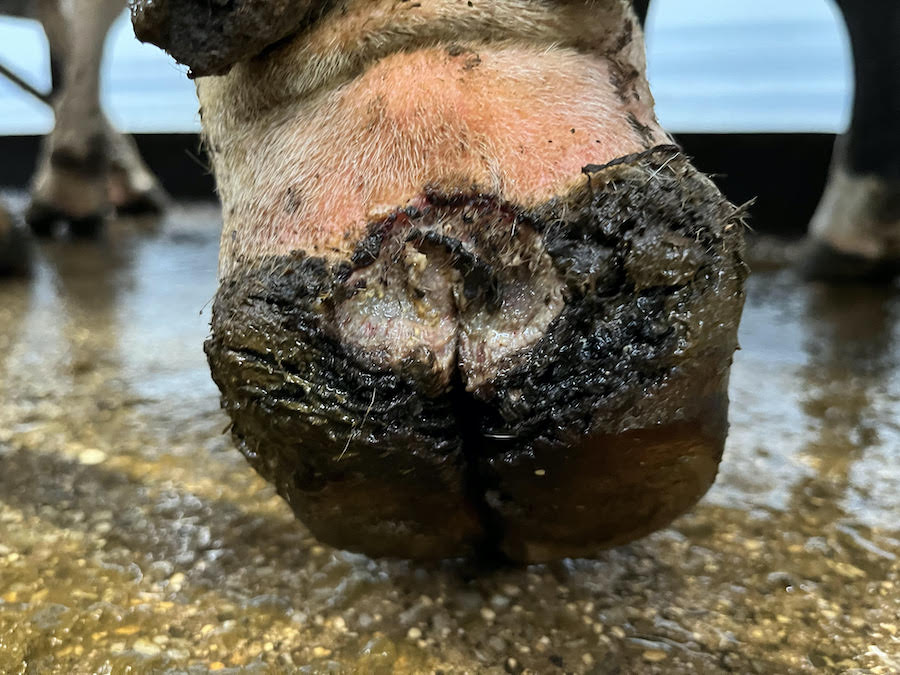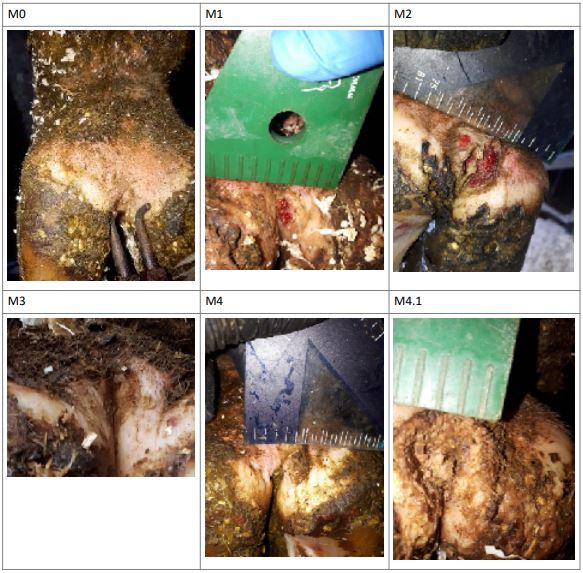Making changes to manage digital dermatitis
19th February 2024
With lameness being common across a range of dairy systems, causing welfare issues and financial losses, Dr James Wilson offers some guidance on prevention and control – and shares trial results from an effective alternative to formalin and copper sulphate footbath solutions.

It is estimated across a range of dairy systems that approximately one in three cows are lame at any given time (Randall et al. 2019). This has come from numerous studies examining prevalence across a range of dairy systems, meaning that this is not a condition unique to the housed high-yielding Holstein.
When we consider the importance of this condition we must first understand the welfare challenge which it presents. Cows that are lame are experiencing pain, irrespective of the severity of the lameness, and require management and treatment accordingly.
Alongside this substantial challenge to the individual animal’s welfare, comes the financial burden which a dairy cow can place on the business. Dairy cows experiencing lameness will give less milk (relative to their potential), are more likely to be reproductively inefficient, and have an increased risk of culling (Huxley, 2013).
A recent estimate published on the AHDB Dairy website estimated that a single case of a sole ulcer in a single lactation would cost the business approximately £580, demonstrating the substantial losses that multiple lameness cases can quickly lead to.
A recent review of the cost of digital dermatitis led to an estimated loss of approximately £107 per case per lactation (with it being common for 40% of the herd to be experiencing these lesions), again showing how important it can be for the efficiency of a business to mitigate these conditions.
Footbathing
Ideally, we should be aiming to footbath the milking cows daily and any dry cows or youngstock at least five days in a week. The key here is to make the task as simple as possible; automatic foot baths can play in important role here, as can simple systems which make the operation as labour free as possible.
Cow flow needs to be maintained, whilst ensuring that the cows are getting at least two foot immersions per day covering up to the dew claws in the foot bath solution, meaning we need the footbath to be at least 3m long.
Quantifying lameness
When looking to make changes on farm, it is critical to first quantify the challenge presented, to understand what impact your management may have on the condition. This can take place three-fold. Firstly, the mobility score is an essential piece of information which can help support evidence-based decision making with regards to lameness management. This data will also allow you to track the progress of any changes made on farm to monitor progress and provide motivation to continue with the changes implemented, or to further develop the management programme on farm.
Secondly, conducting a review of foot trimming records will allow you to examine the severity of lameness being observed on farm either by a contracted trimmer, or by an in-house trimmer. Again, these records allow you to steer your decision making in a much more concise manner and ensure that your management changes are relevant to the causes of lameness on your farm.
Finally, as part of conducting a digital dermatitis review, it is useful to conduct a parlour score for digital dermatitis, with the M-Stage of disease being noted alongside the animal ID. An M-Score in-parlour typically takes the form of the back feet being gently rinsed off during milking, with a trained individual then using a mirror to assess the cows for digital dermatitis and marking those that would benefit from treatment (i.e. any cow with a digital dermatitis lesion).
This will not only allow you to identify all animals that will benefit from treatment (as animals may have DD, but not be easily identifiable as lame), but will also allow for much deeper investigation into the root of a digital dermatitis problem by your attending clinician and mobility mentor.
The M-Scoring system, see images, allows for the nature of the digital dermatitis problem to be monitored closely and to identify the nature of lesion regression and cure rates when ‘blitz’ treatments (three days of consecutive topical treatment for all animals with visible lesions, for example) are implemented.

Trial results show success for footbath solution
Provita has developed a proprietary footbath solution, Hoofsure Endurance, with over 40 trials across three continents and it is well placed to help dairy farms get on top of and control lameness. Notable research shows it is up to 44% more effective than formalin and copper sulphate with proven antibacterial activity.
The product is highly concentrated allowing 5,000 cows/8,000 sheep per 20 litres. The Hoofsure range also includes Konquest topical hoof gel and Combat hoof spray for individual hoof application.
Hoofsure Endurance is widely used on sheep farms. An independent clinical study on the effectiveness of footbath solutions in sheep found that 65% of sheep improved after one pass through a footbath containing Hoofsure Endurance at 2% dilution rate. Foot rot and scald account for 90% of lameness in most sheep farms.
Attention to the foot health of the entire flock, and avoidance of transmission of highly infectious pathogens coupled with rapid action, regular foot baths, vaccination and good biosecurity will underpin successful management of lameness prevention.
Read more livestock stories here.
